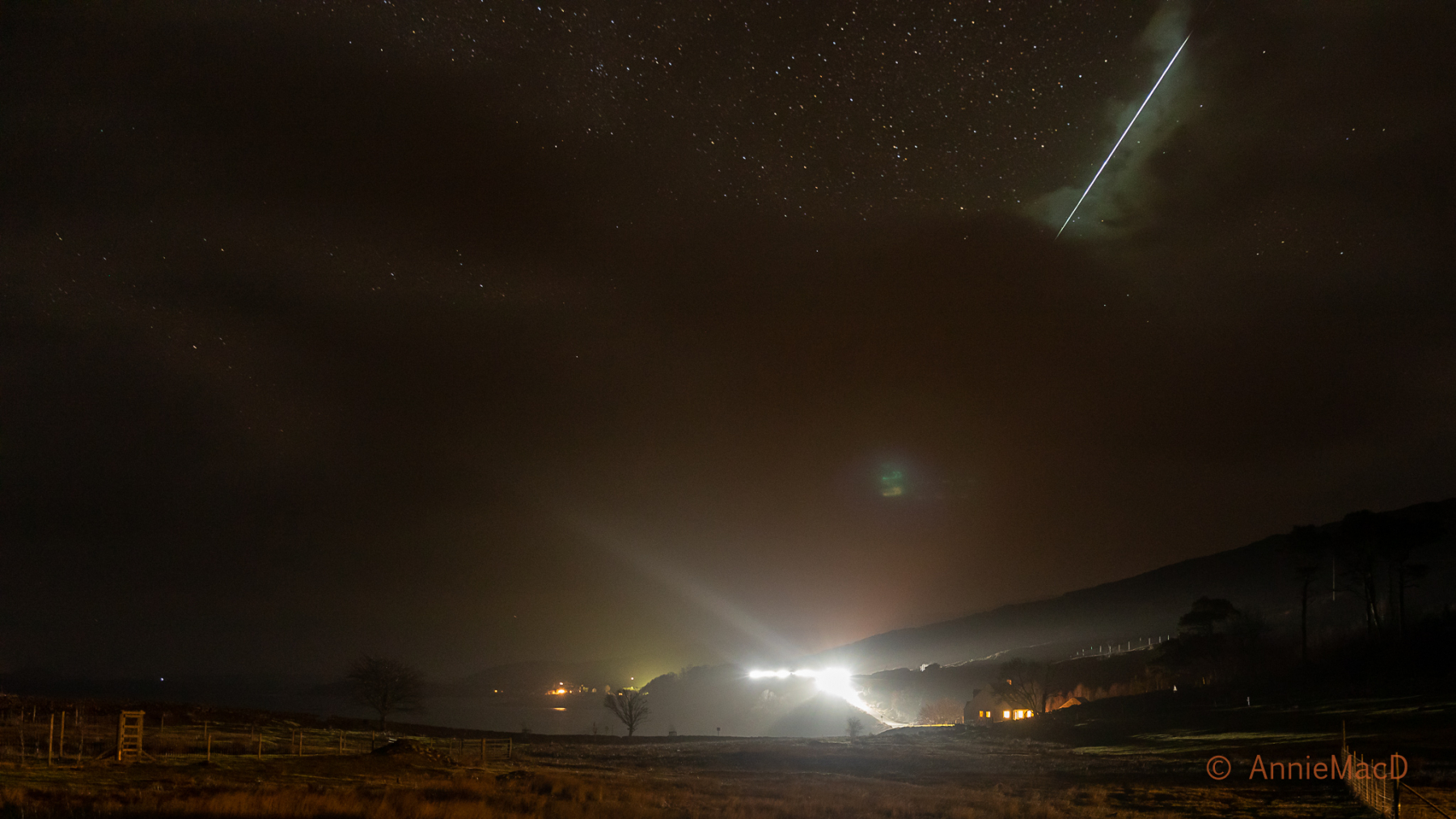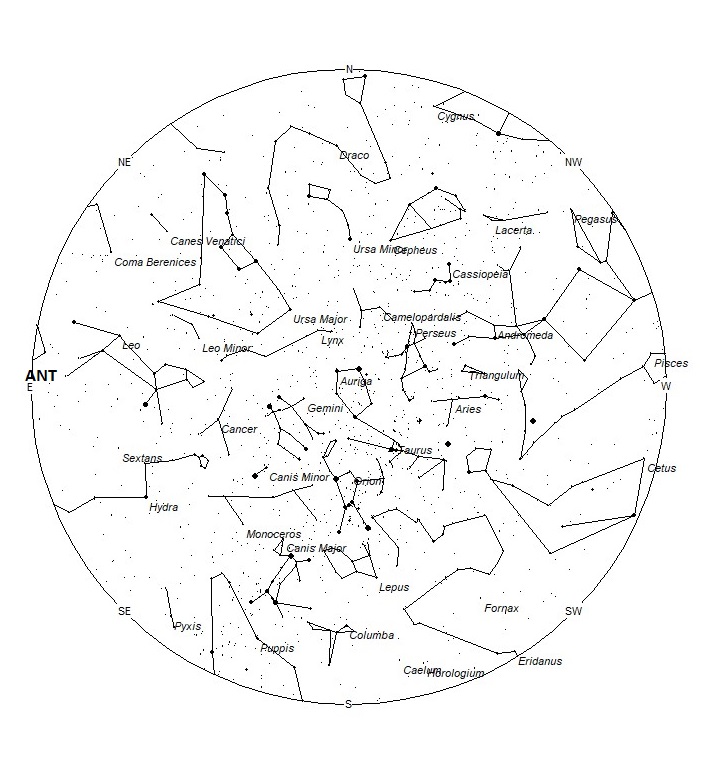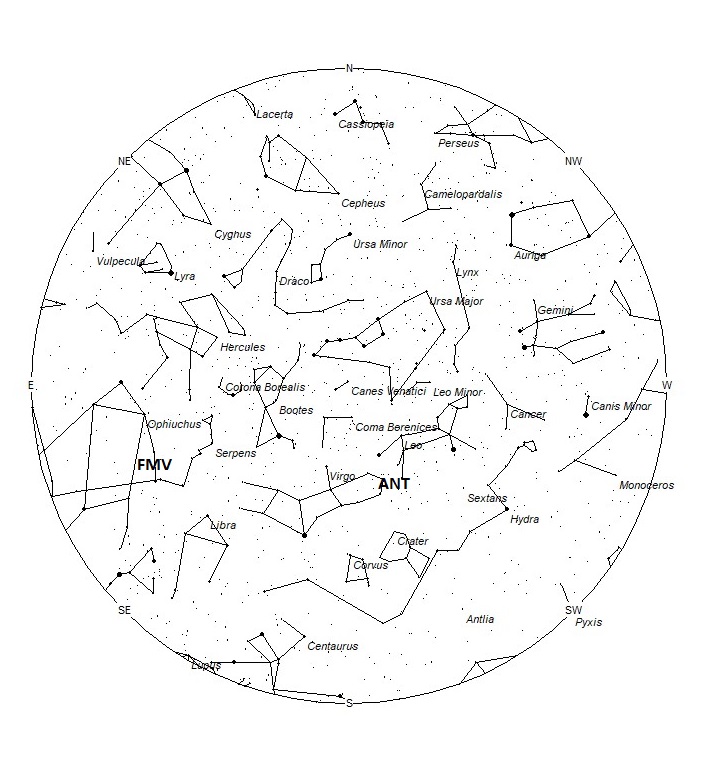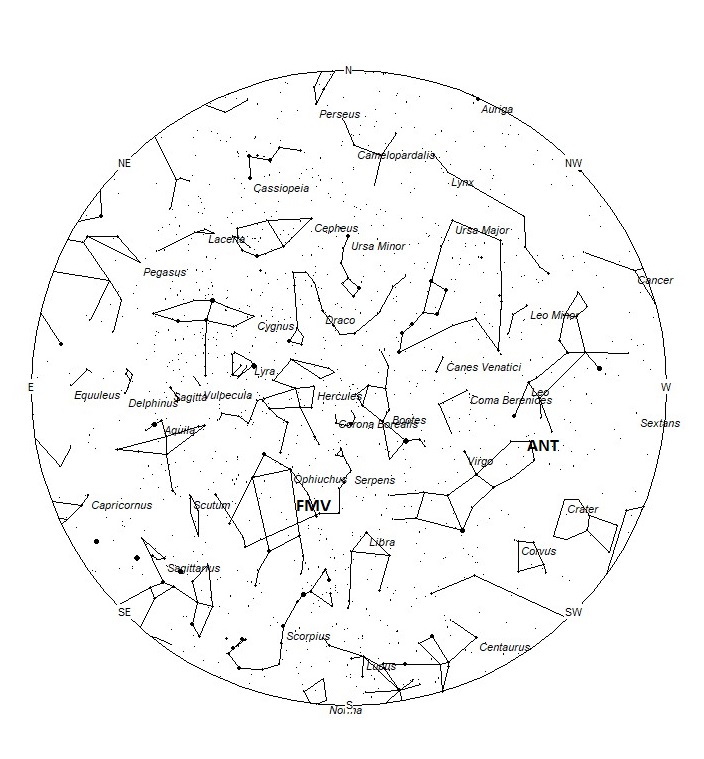
As seen from the northern hemisphere, March is the slowest month of the year for meteor activity. No major annual showers are active and only a few very weak minor showers produce activity this month. The sporadic rates are also near their annual minimum so there is not much to look forward to this month except for the evening fireballs that seem to peak this time of year as seen from the northern hemisphere. This could be due to the fact the Antapex radiant lies highest above the horizon this time of year during the evening hours. From the southern hemisphere, activity from the Centaurid complex begins to wane with only the weak activity visible from Norma and perhaps others nearby areas. At least southern sporadic rates are still strong to make the late summer viewing a bit more pleasurable.
During this period the moon reaches its first quarter phase on Tuesday March 3rd. At this time the moon will set near midnight local standard time (LST), allowing the remainder of the night to be free of interrupting moonlight. The estimated total hourly meteor rates for evening observers this week is near 2 for those viewing from the northern hemisphere and 3 for those located south of the equator. For morning observers, the estimated total hourly rates should be near 12 as seen from tropical southern locations (25S) and 7 as seen from mid-northern latitudes (45N). The actual rates will also depend on factors such as personal light and motion perception, local weather conditions, alertness and experience in watching meteor activity. Evening rates are reduced during this period due to moonlight. Note that the hourly rates listed below are estimates as viewed from dark sky sites away from urban light sources. Observers viewing from urban areas will see less activity as only the brighter meteors will be visible from such locations.
The radiant (the area of the sky where meteors appear to shoot from) positions and rates listed below are exact for Saturday night/Sunday morning February 29/March 1. These positions do not change greatly day to day so the listed coordinates may be used during this entire period. Most star atlases (available at science stores and planetariums) will provide maps with grid lines of the celestial coordinates so that you may find out exactly where these positions are located in the sky. A planisphere or computer planetarium program is also useful in showing the sky at any time of night on any date of the year. Activity from each radiant is best seen when it is positioned highest in the sky, either due north or south along the meridian, depending on your latitude. It must be remembered that meteor activity is rarely seen at the radiant position. Rather they shoot outwards from the radiant, so it is best to center your field of view so that the radiant lies at the edge and not the center. Viewing there will allow you to easily trace the path of each meteor back to the radiant (if it is a shower member) or in another direction if it is a sporadic. Meteor activity is not seen from radiants that are located below the horizon. The positions below are listed in a west to east manner in order of right ascension (celestial longitude). The positions listed first are located further west therefore are accessible earlier in the night while those listed further down the list rise later in the night.
These sources of meteoric activity are expected to be active this week.
.
The center of the large Anthelion (ANT) radiant is currently located at 11:32 (173) +03. This position lies in southeastern Leo, 4 degrees southeast of the 4th magnitude star known as sigma Leonis. Due to the large size of this radiant, Anthelion activity may also appear from Sextans and western Virgo as well as southeastern Leo. This radiant is best placed near 0200 local summer time (LST), when it lies on the meridian and is located highest in the sky. Rates at this time should be near 2 per hour no matter your location. With an entry velocity of 30 km/sec., the average Anthelion meteor would be of slow velocity.
The February Mu Virginids (FMV) were discovered by Damir Šegon and the Croatian Meteor Network team based on studying SonotaCo and CMN observations (SonotaCo 2007-2011, CMN 2007-2010). These meteors are active from February 17 through March 5 with maximum activity occurring on February 26. The current radiant position lies near 16:36 (249) -01, which actually places it in western Ophiuchus, 3 degrees southeast of the 4th magnitude star known as Marfik (lambda Ophiuchi). Rates are expected to be less than 1 per hour no matter your location. These meteors are best seen during the last hour prior to dawn when the radiant lies highest above the horizon in a dark sky At 62 km/sec. the February Mu Virginids would produce mostly swift meteors.
As seen from the mid-northern hemisphere (45N) one would expect to see approximately 5 sporadic meteors per hour during the last hour before dawn as seen from rural observing sites. Evening rates would be near 1 per hour. As seen from the tropical southern latitudes (25S), morning rates would also be near 10 per hour as seen from rural observing sites and 2 per hour during the evening hours. Locations between these two extremes would see activity between the listed figures. Evening rates are reduced during this period due to moonlight.
The list below offers the information from above in tabular form. Rates and positions are exact for Saturday night/Sunday morning except where noted in the shower descriptions.
| SHOWER | DATE OF MAXIMUM ACTIVITY | CELESTIAL POSITION | ENTRY VELOCITY | CULMINATION | HOURLY RATE | CLASS |
| RA (RA in Deg.) DEC | Km/Sec | Local Standard Time | North-South | |||
| Anthelion (ANT) | – | 11:32 (173) +03 | 30 | 01:00 | 2 – 2 | II |
| February mu Virginids (FMV) | Feb 26 | 16:36 (249) -01 | 65 | 07:00 | <1 – <1 | IV |
 American Meteor Society
American Meteor Society


